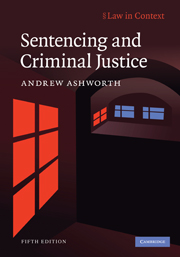Book contents
- Frontmatter
- Contents
- Preface
- Table of legislative measures
- Table of cases
- 1 An introduction to English sentencing
- 2 Sentencing and the constitution
- 3 Sentencing aims, principles and policies
- 4 Elements of proportionality
- 5 Aggravation and mitigation
- 6 Persistence, prevention and prediction
- 7 Equality before the law
- 8 Multiple offenders
- 9 Custodial sentencing
- 10 Non-custodial sentencing
- 11 Procedural issues and ancillary orders
- 12 Special sentencing powers
- 13 Conclusions
- Appendix: The Sentencing Council: provisions in the Coroners and Justice Act 2009
- References
- Index
12 - Special sentencing powers
Published online by Cambridge University Press: 05 June 2012
- Frontmatter
- Contents
- Preface
- Table of legislative measures
- Table of cases
- 1 An introduction to English sentencing
- 2 Sentencing and the constitution
- 3 Sentencing aims, principles and policies
- 4 Elements of proportionality
- 5 Aggravation and mitigation
- 6 Persistence, prevention and prediction
- 7 Equality before the law
- 8 Multiple offenders
- 9 Custodial sentencing
- 10 Non-custodial sentencing
- 11 Procedural issues and ancillary orders
- 12 Special sentencing powers
- 13 Conclusions
- Appendix: The Sentencing Council: provisions in the Coroners and Justice Act 2009
- References
- Index
Summary
This chapter deals with three sets of sentencing powers for particular groups of offender. It begins with the sentencing of young offenders under the age of 18, deals briefly with young adult offenders aged from 18 to 21, and then concludes with the various powers for dealing with mentally disordered offenders. In respect of each group, we will consider the justifications for separate sentencing powers, and the extent to which the rationale for special powers carries through into sentencing practice.
Young offenders
For almost the whole of the last century there were different sentencing procedures for younger offenders. Those aged under 17 (after the Criminal Justice Act 1991, under 18) were dealt with in different courts, formerly called juvenile courts and then renamed ‘youth courts’. There is a considerable literature about the development of sentencing policy in respect of young offenders, whereas the discussion here is necessarily briefer.
A short history of juvenile justice
Ever since 1933, the law has laid down that, in dealing with a juvenile offender, a court ‘shall have regard to the welfare of the child or young person’. This welfare ideology reached its apotheosis in the Children and Young Persons Act 1969, which sought to ‘decriminalize’ the juvenile court by regarding the commission of an offence as merely one way in which the court's powers to intervene for the welfare of the child could be activated.
- Type
- Chapter
- Information
- Sentencing and Criminal Justice , pp. 388 - 412Publisher: Cambridge University PressPrint publication year: 2010



